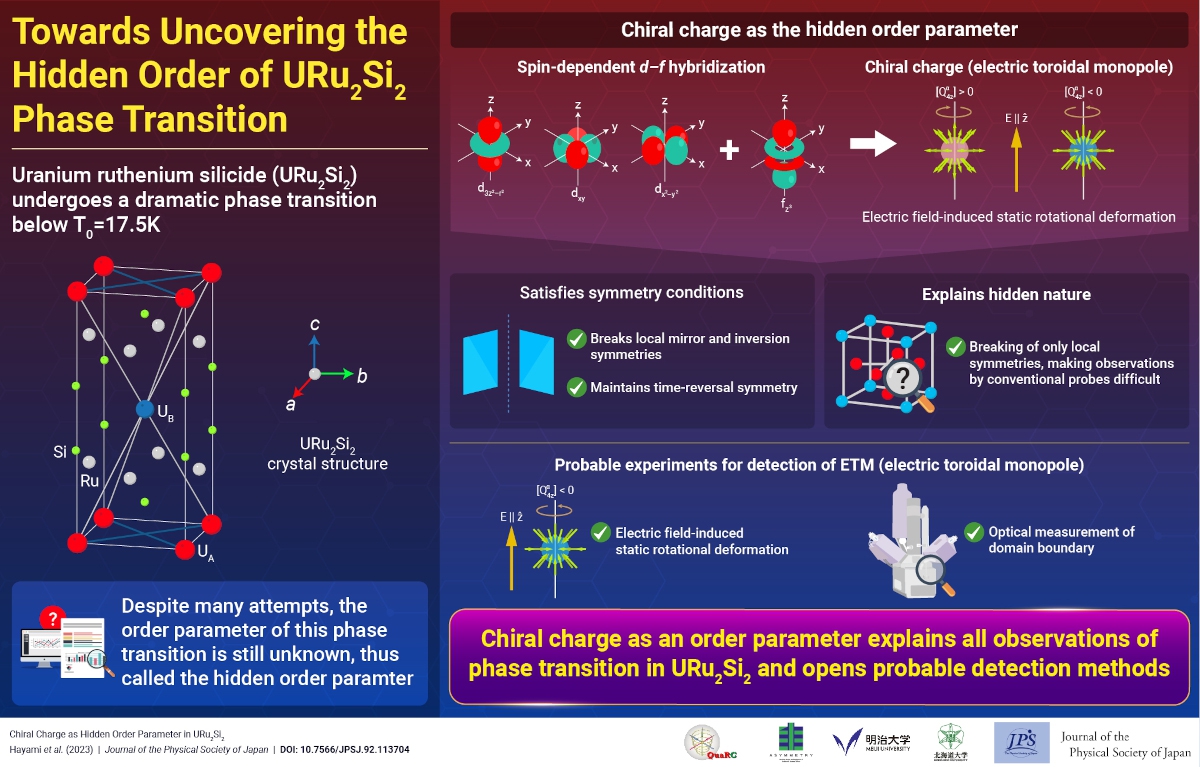Towards Uncovering the Hidden Order of URu2Si2 Phase Transition
© The Physical Society of Japan
This article is on
Chiral Charge as Hidden Order Parameter in URu2Si2
(JPSJ Editors' Choice)
J. Phys. Soc. Jpn.
92,
113704
(2023)
.
We propose a chiral charge as the hidden order parameter in URu2Si2 and present experiments to detect it by focusing on breakings of mirror and inversion symmetries at the local uranium ion.

In condensed matter physics, various types of phase transitions have been observed and their nature has been clarified by intensive experimental and theoretical studies. However, the order parameter of the phase below critical temperature T0 = 17.5 K in URu2Si2 has still been uncovered since its discovery in 1985 despite many efforts by several researchers. With the latest and high-resolution experiments, such as nuclear magnetic resonance, muon spin relaxation, and resonant X-ray scattering measurements, the symmetry of local environment of ions has been narrowed down. This enigmatic ordered phase is called the hidden order. Meanwhile, the candidate order parameter compatible with known experimental facts has recently been clarified from the symmetry aspect by Kambe et al. [Phys. Rev. B 97, 235142 (2018)], although its microscopic object and experimental identification have still been unclear.
In the present study, we theoretically propose that a staggered alignment of chiral charge, that appears in association with electron motion in crystals, corresponds to the hidden order parameter in URu2Si2, satisfying all the symmetry conditions accumulated by many experiments. The chiral charge represents composite degrees of freedom consisting of a spin and a hybridization between orbitals with different orbital angular momenta that can be regarded as a pseudoscalar monopole distinct from conventional electric and magnetic monopoles. Because it only locally breaks the mirror and inversion symmetries, the observation using microscopic probes is difficult; therefore, the order parameter is still hidden. By considering the minimal effective d-f hybridized model on the itinerant picture, we propose the methods to observe the hidden order parameter in experiments. One is an electric-field-induced static rotational deformation in bulk. The other is the observation of states at the surface or domain boundary that can be detected by state-of-the-art experimental methods such as nuclear quadrupole resonance and scanning transmission electron microscopy combined with convergent-beam electron diffraction under an electric field and circularly polarized second harmonic generation microscopy. Our result may provide the last information to resolve the hidden order parameter in URu2Si2.
(Written by Satoru Hayami on behalf of all authors.)
Chiral Charge as Hidden Order Parameter in URu2Si2
(JPSJ Editors' Choice)
J. Phys. Soc. Jpn.
92,
113704
(2023)
.
Share this topic
Fields
Related Articles
-
Higher-Order Topological Phases in Magnetic Materials with Breathing Pyrochlore Structures
Electronic structure and electrical properties of surfaces and nanostructures
Magnetic properties in condensed matter
Mathematical methods, classical and quantum physics, relativity, gravitation, numerical simulation, computational modeling
2025-4-7
A simple example of a higher-order topological phase, in which the symmetry decreases step-by-step from the bulk to the corner, is realized in a magnetic system with a pyrochlore structure and is characterized by a series of quantized Berry phases defined for the bulk, surface, and edge.
-
Existence of Chiral Soliton Lattices (CSLs) in Chiral Helimagnet Yb(Ni1-xCux)3Al9
Magnetic properties in condensed matter
2025-4-1
Our study examines the magnetic structure of the monoaxial chiral helimagnet Yb(Ni1-xCux)3Al9, providing first direct evidence of the formation of chiral soliton lattice state.
-
Understanding Pressure-Induced Superconductivity in CrAs and MnP
Magnetic properties in condensed matter
2025-3-10
This study reviews existing research on the pressure-induced variation of magnetic properties of transition metal mono-pnictides like CrAS, MnP, and others, aiming to understand the unconventional superconductivity observed in CrAs and MnP.
-
Symmetry and AI: Building the Future of Physics Simulations
Magnetic properties in condensed matter
Measurement, instrumentation, and techniques
2025-2-18
Generative artificial intelligence (AI) has gained considerable attention in scientific fields. By embedding physical symmetry into AI before training, we created a faster and lighter model. Scaling improves the accuracy and unlocks the potential of physics research and applications.
-
Triangular Lattice Magnet GdGa2: Spin Cycloids and Skyrmions
Cross-disciplinary physics and related areas of science and technology
Electronic transport in condensed matter
Magnetic properties in condensed matter
2025-2-3
Careful measurements were conducted on the hexagonal magnet GdGa2 to reveal the experimental signatures of ultrasmall spin cycloids and of a potential Néel-type skyrmion lattice phase induced by a magnetic field.




